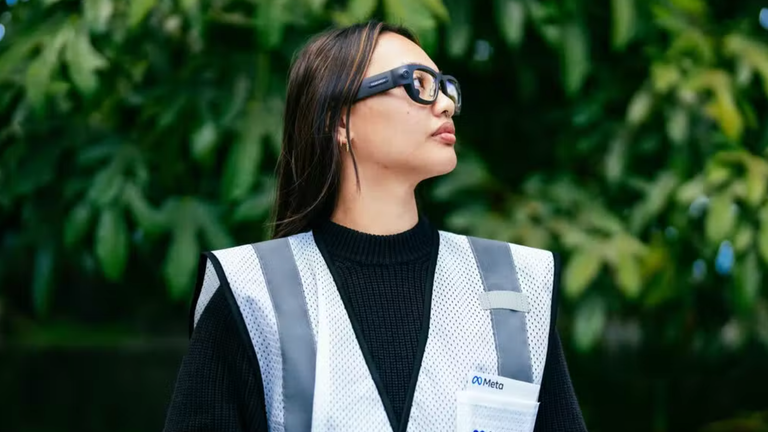Smartwear companies open fire to start the race for our faces | Science & Technology News

Following the commercial success of Facebook’s Oculus virtual reality headset, companies are now racing to develop the first augmented reality (AR) headset aimed at the consumer market.
AR has been around for a while in consumer tech circles, especially popular in Instagram and Snapchat filters on smartphones.
However, several companies are now moving towards the sci-fi vision of Tony Stark’s fictional Iron Man sunglasses.
Several products are already on the market that combine your computer monitor with reality.
Instead of placing you in a third space, like a VR headset, AR overlays the real world with a clear user interface and other graphics on top of a clear lens, while simultaneously sensing and filming the world around you.
So far, AR headsets in the UK have been targeted for business use, given their relatively high price tag and unfashionable styling.
Meta became the first company in the UK to release a pair of glasses with a built-in camera when it partnered with Ray-Ban last year, aimed at the consumer retail market.
Wearers can listen to music, take photos, and record videos with a pair of Ray-Ban Stories, which are automatically shared to your smartphone.
Stories are primarily designed for content creation and do not display anything on the wearer’s lens.
EE partners with Nreal for AR glasses
This week, however, a company called Nreal, in association with mobile phone provider EE, released a pair of AR glasses designed for content consumption.
The headset, which connects to your Android smartphone via a USBC cable, casts your phone’s screen to the 201″ screen on your lens, wherever you are in the world.
The wearer can mirror the phone screen directly onto the glass, or use an operating system that allows the user to open and resize multiple windows at the same time, just like on a computer.
Users can choose to view the screen on a transparent lens or apply a plastic visor to create a more cinematic experience.
The glasses work like a TV screen or a second screen, except that you’re carrying the TV in a discreet case in your backpack.
The Nreal Air glasses also allow for iMAX-sized video games on the go.
When connected to EE’s much-advertised superfast 5G network, using Xbox’s cloud game streaming or PlayStation’s Play Remote app, wearers can play their console in anywhere they can get a signal.
A new chapter for consumers
The Air headphones mark a new chapter in consumer entertainment.
It costs £399 (less than half that of its commercial counterparts) and EE expects no production or shipping delays during the rollout.
Danny Marshall, head of device partnerships at EE, told Sky News: “[Nreal] really being very selective about the markets where you can buy their product, so will make sure they can centralize the supply… what we need to do quickly is understand the demand – that is more of a challenge than component availability. “
He points out that many people still don’t really know that AR is powering their Instagram filters, and the company doesn’t know how long it will take for the wearable technology to be widely adopted.
Then the next technological step would be for companies to combine Ray-Ban Stories’ cameras with Nreal’s 1080p displays.
“If you look broadly, most of the technology that exists … enhanced information display already exists, it’s leaning towards customer adoption.
“Most of the technology is there, just making it smaller, lighter, easier to wear – the battery is the big rest, it’s all there.”
Meta testing AR glasses in London
And Meta tends to agree.
Meta has announced that it has begun testing its own augmented reality glasses in London, which will record video and audio, as well as track eye movements.
Speaking to Sky News, Jason Rubin, vice president of Metaverse Content at Meta, explained the benefits developers at Facebook are seeing in AR.
“Augmented reality is great when you’re in real life – so I can use augmented reality walking down the street because I can see cars and other people, and get Be informed just like I took out my phone today but in a much more efficient way.
“The perfect device that will do both [AR and VR] and just switch to full immersion or let things go depending on what makes sense at any given time – and Mark Zuckerberg recently showed that’s happening inside Cambria. “
While Meta says that this particular model is not a prototype and will never make it to market, the technology still exists.
Now it’s only a matter of time until it can be scaled and manufactured at scale and at a price point that people will buy in.
Real life is ‘number one’
Surprisingly, Mr. Rubin went on to say that he “would rather be in a room with [his manager] In real life, it’s number one. If I can’t be in the room with him, I’d rather be in cyberspace with him in VR.”
He told Sky News that Meta employees are still working on a combined basis and will likely continue to do so.
“I know the entire company will be thrilled that we’re getting back together… we’re all wondering what the point of the long-term settlement of all of this is going to be.”
Read more:
Time to update your story game as the app adds augmented reality effects
Apple and Google prepare for Augmented Reality clash
Facebook and Apple smart glasses coming to us soon
Despite the leaps and bounds in VR and AR technology, Mr. Rubin said he doesn’t think immersive eyewear will be the only way for us to approach the Metaverse:
“I think over time, augmented reality will become more and more a part of our lives… but I think there’s going to be a lot of times when we’re not in vivid reality and we’ll want to use 2D screens… so the screen will last for a long time. Maybe forever.”
What’s clear is that smart features don’t just stop at Fitbit or Apple Watch.
The race for our faces is on.








